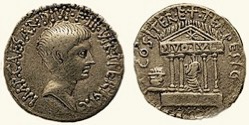

Temple of Divus Julius

IMP CAESAR DIVI F III·VIR ITER R P C/ DIVO IVL - COS ITER ET TER DESIG (RRC 540/1, 36 BC)
Temple of Divus Julius depicted on the reverse
Cassius Dio recorded that:
-
“... on the first day of [42 BC, the triumvirs] ... [inter alia] ... laid the foundation of a shrine to him, as hero, [i.e of the Temple of Divus Julius] in the forum, on the spot [in the Forum] where his body had been burned” (‘Roman History’, 47: 18).
According to Darryl Phillips (referenced below, at p. 376):
-
“A coin series of 36 BC [RRC 540/1 and 540/2, issued at the time of Octavian’s victory at Naulochus] provides our first glimpse of the structure and may mark the commencement of construction.”
The obverse designs that featured the Temple of Divus Julius, clearly designated by the words “DIVO IVL” on the architrave:
-
✴a cult statue stands between the temple columns; and
-
✴the sidus Iulium, the star or comet that had proclaimed his apotheosis during the Ludi Veneris Genitricis of 44 BC (above) is represented in the pediment.
The altar to divus Julius that had been erected on the site in the forum in 44 BC to mark his cremation is shown to the left of the planned temple.
Cassius Dio recorded that, after Octavian’s victory at Actium in 31 BC:
-
“... the Romans at home had passed many resolutions in honour of Caesar's naval victory. Thus they granted him a triumph, as over Cleopatra, an arch adorned with trophies at Brundisium and another in the Roman Forum. Moreover, they decreed that the foundation of the shrine of [divus] Julius should be adorned with the beaks of the captured ships” (‘Roman History’, 51: 19).
He also noted that, immediately after Octavian’s triple triumph of 29 BC (for his victories in Dalmatia, at Actium and in Egypt):
-
“The shrine of [divus] Julius ... was consecrated at this time [and some of the spoils of war in Egypt] were placed in it ...”, (‘Roman History’, 51: 22).
Thus it seems that the Temple of Divus Julius served as one of the loci for the celebration of Octavian’s victories and, although it had long been planned, it was essentially built using the spoils of war.
Darryl Phillips (referenced below, at p. 382) also noted the links between the Temple of Divus Julius and the Temple of Venus Genetrix:
-
“The Temple of Divus Julius was characterised by close-set columns. This pycnostyle arrangement was unusual in Rome; Vitruvius (‘Ten Books on Architecture’, 3.3.2) names only the Temple of Divus Julius and Caesar's temple to Venus Genetrix as examples of this style in the city. Furthermore, just as Caesar had dedicated the Temple of Venus Genetrix in connection with the celebration of his triumph in 46 BC, in similar fashion Octavian dedicated the Temple of Divus Julius on August 18, 29 BC, immediately following the celebration of his own triple triumph.”

